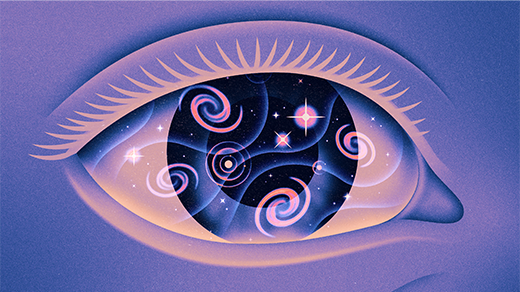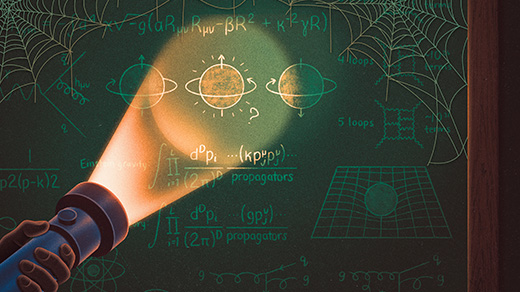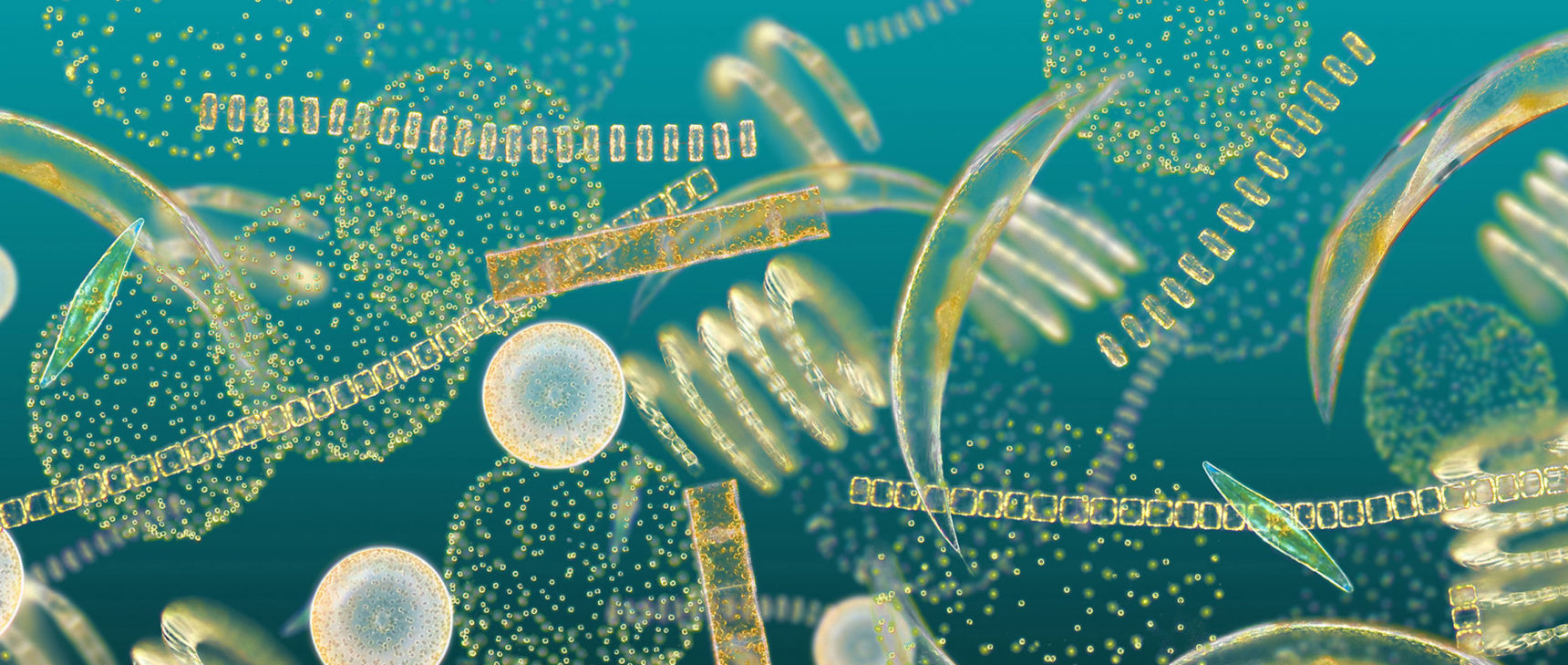Neutron Lifetime Puzzle Deepens, but No Dark Matter Seen
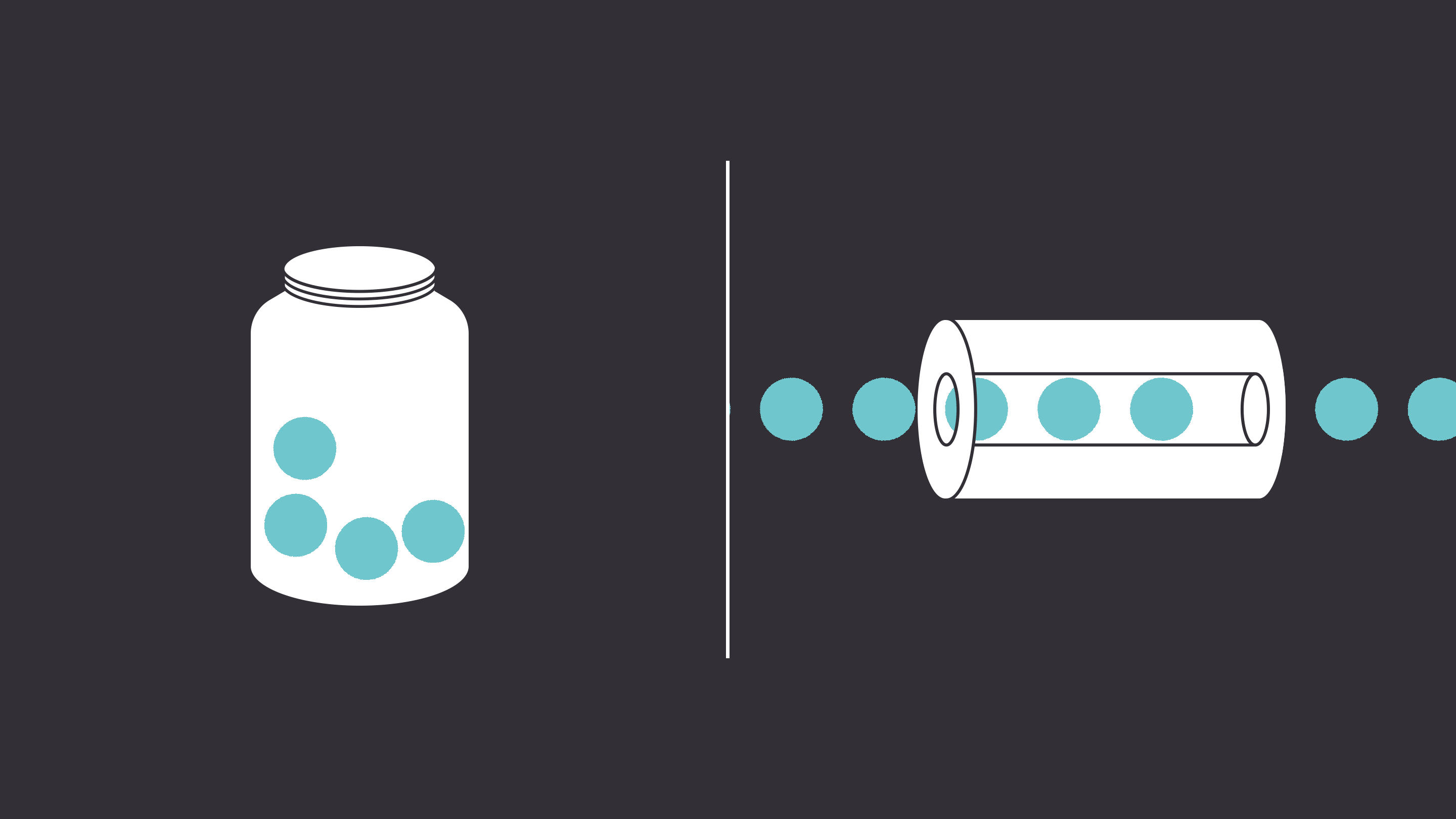
Daniel Savage for Quanta Magazine
Introduction
When physicists strip neutrons from atomic nuclei, put them in a bottle, then count how many remain there after some time, they infer that neutrons radioactively decay in 14 minutes and 39 seconds, on average. But when other physicists generate beams of neutrons and tally the emerging protons — the particles that free neutrons decay into — they peg the average neutron lifetime at around 14 minutes and 48 seconds.
The discrepancy between the “bottle” and “beam” measurements has persisted since both methods of gauging the neutron’s longevity began yielding results in the 1990s. At first, all the measurements were so imprecise that nobody worried. Gradually, though, both methods have improved, and still they disagree. Now, researchers at Los Alamos National Laboratory in New Mexico have made the most precise bottle measurement of the neutron lifetime yet, using a new type of bottle that eliminates possible sources of error in earlier designs. The result, which will soon appear in the journal Science, reinforces the discrepancy with beam experiments and increases the chance that it reflects new physics rather than mere experimental error.
But what new physics? In January, two theoretical physicists put forward a thrilling hypothesis about the cause of the discrepancy. Bartosz Fornal and Benjamin Grinstein of the University of California, San Diego, argued that neutrons might sometimes decay into dark matter — the invisible particles that seem to make up six-sevenths of the matter in the universe based on their gravitational influence, while evading decades of experimental searches. If neutrons sometimes transmogrify into dark matter particles instead of protons, then they would disappear from bottles at a faster rate than protons appear in beams, exactly as observed.
Fornal and Grinstein determined that, in the simplest scenario, the hypothetical dark matter particle’s mass must fall between 937.9 and 938.8 mega-electron volts, and that a neutron decaying into such a particle would emit a gamma ray of a specific energy. “This is a very concrete signal that experimentalists can look for,” Fornal said in an interview.
The UCNtau experimental team in Los Alamos — named for ultracold neutrons and tau, the Greek symbol for the neutron lifetime — heard about Fornal and Grinstein’s paper last month, just as they were gearing up for another experimental run. Almost immediately, Zhaowen Tang and Chris Morris, members of the collaboration, realized they could mount a germanium detector onto their bottle apparatus to measure gamma-ray emissions while neutrons decayed inside. “Zhaowen went off and built a stand, and we got together the parts for our detector and put them up next to the tank and started taking data,” Morris said.
Data analysis was similarly quick. On Feb. 7, just one month after Fornal and Grinstein’s hypothesis appeared, the UCNtau team reported the results of their experimental test on the physics preprint site arxiv.org: They claim to have ruled out the presence of the telltale gamma rays with 99 percent certainty. Commenting on the outcome, Fornal noted that the dark matter hypothesis is not entirely excluded: A second scenario exists in which the neutron decays into two dark matter particles, rather than one of them and a gamma ray. Without a clear experimental signature, this scenario will be far harder to test. (Fornal and Grinstein’s paper, and the UCNtau team’s, are now simultaneously under review for publication in Physical Review Letters.)
So there’s no evidence of dark matter. Yet the neutron lifetime discrepancy is stronger than ever. And whether free neutrons live 14 minutes and 39 or 48 seconds, on average, actually matters.
Physicists need to know the neutron’s lifetime in order to calculate the relative abundances of hydrogen and helium that would have been produced during the universe’s first few minutes. The faster neutrons decayed to protons in that period, the fewer would have existed later to be incorporated into helium nuclei. “That balance of hydrogen and helium is first of all a very sensitive test of the dynamics of the Big Bang,” said Geoffrey Greene, a nuclear physicist at the University of Tennessee and Oak Ridge National Laboratory, “but it also tells us how stars are going to form over the next billions of years,” since galaxies with more hydrogen form more massive, and eventually more explosive, stars. Thus, the neutron lifetime affects predictions of the universe’s far future.
Furthermore, both neutrons and protons are actually composites of elementary particles called quarks that are held together by gluons. Outside of stable atomic nuclei, neutrons decay when one of their down quarks undergoes weak nuclear decay into an up quark, transforming the neutron into a positively charged proton and spitting out a negative electron and an antineutrino in compensation. Quarks and gluons can’t themselves be studied in isolation, which makes neutron decays, in Greene’s words, “our best surrogate for the elementary quark interactions.”
The lingering nine-second uncertainty in the neutron lifetime needs resolving for these reasons. But no one has a clue what’s wrong. Greene, who is a veteran of beam experiments, said, “All of us have gone over very carefully everybody’s experiment, and if we knew where the problem was we would identify it.”
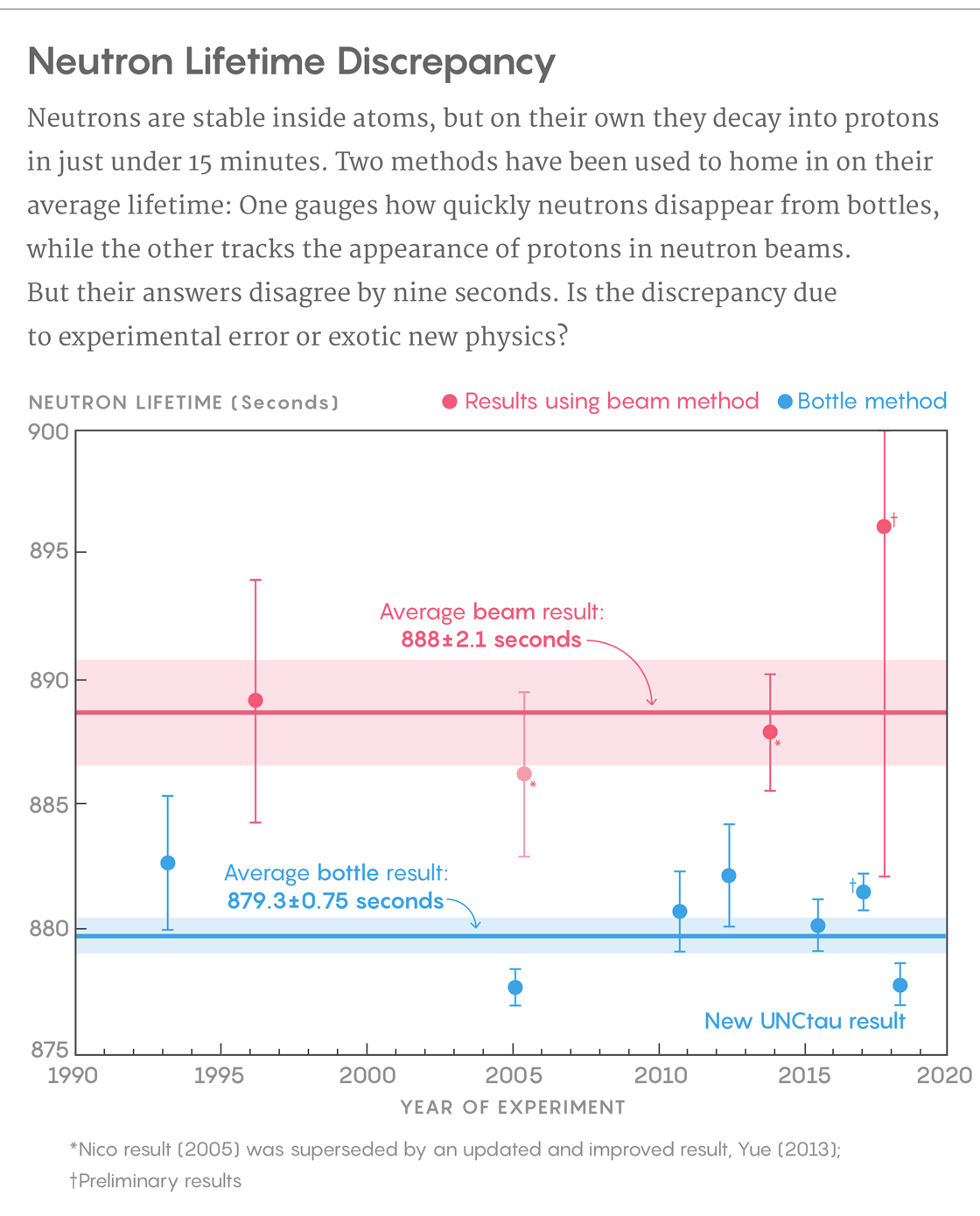
Lucy Reading-Ikkanda/Quanta Magazine; Source: pre-2017, Particle Data Group; Serebrov 2017, arxiv:1712.05663; Pattie, 2018, arxiv:1707.01817
The discrepancy first became a serious matter in 2005, when a group led by Anatoli Serebrov of the Petersburg Nuclear Physics Institute in Russia and physicists at the National Institute of Standards and Technology (NIST) in Gaithersburg, Maryland, reported bottle and beam measurements, respectively, that were individually very precise — the bottle measurement was estimated to be at most one second off, and the beam one at most three seconds — but which differed from each other by eight seconds.
Many design improvements, independent checks and head scratches later, the gap between the world-average bottle and beam measurements has only grown slightly — to nine seconds — while both error margins have shrunk. This leaves two possibilities, said Peter Geltenbort, a nuclear physicist at the Institut Laue-Langevin in France who was on Serebrov’s team in 2005 and is now part of UCNtau: “Either there is really some exotic new physics,” or “everyone was overestimating their precision.”
Beam practitioners at NIST and elsewhere have worked to understand and minimize the many sources of uncertainty in their experiments, including in the intensity of their neutron beam, the volume of the detector that the beam passes through, and the efficiency of the detector, which picks up protons produced by decaying neutrons along the beam’s length. For years, Greene particularly mistrusted the beam-intensity measurement, but independent checks have exonerated it. “At this point I don’t have a best candidate of a systematic effect that’s been overlooked,” he said.
On the bottle side of the story, experts suspected that neutrons might be getting absorbed into their bottles’ walls despite the surfaces being coated with a smooth and reflective material, and even after correcting for wall losses by varying the bottle size. Alternatively, the standard way of counting surviving neutrons in the bottles might have been lossy.
But the new UCNtau experiment has eliminated both explanations. Instead of storing neutrons in a material bottle, the Los Alamos scientists trapped them using magnetic fields. And rather than transporting surviving neutrons to an external detector, they employed an in situ detector that dips into the magnetic bottle and quickly absorbs all the neutrons inside. (Each absorption produces a flash of light that gets picked up by phototubes.) Yet their final answer corroborates that of previous bottle experiments.
The only option is to press on. “Everybody is moving forward,” Morris said. He and the UCNtau team are still collecting data and finishing up an analysis that includes twice as much data as in the forthcoming Science paper. They aim to eventually measure tau with an uncertainty of just 0.2 second. On the beam side, a group at NIST led by Jeffrey Nico is taking data now and expects to have results in two years, aiming for one-second uncertainty, while an experiment in Japan called J-PARC is also getting under way.
NIST and J-PARC will either corroborate UCNtau’s result, deciding the neutron lifetime once and for all, or the saga will continue.
“The tension that these two independent methods disagree is what drives the improvement in the experiments,” Greene said. If only the bottle or the beam technique had been developed, physicists might have gone forward with the wrong value for tau plugged into their calculations. “The virtue of having two independent methods is it keeps you honest. I used to work at the National Bureau of Standards, and they’d say, ‘A man with one watch knows what time it is; a man with two is never sure.’”
This article was reprinted on Wired.com.

